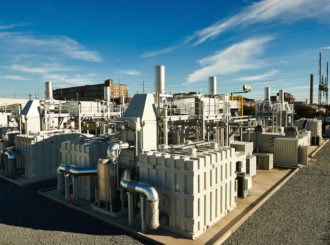Largest Fuel Cell Installation in North America
The recent development of the high-profile, state-of-the-art Bridgeport Fuel Cell Park Project was a true test of teamwork and innovation. This power generating facility is currently the largest of its kind in North America and the second largest in the world. With the ability to produce 14.9+ megawatts of clean, quiet energy, this is an excellent example of a project that was made possible through collaboration and mutual respect.
A/Z and our partners joined our resources to manage every stage of this project—from the initial design of the site and manufacture of the fuel cell units to the construction, startup, commissioning, and operation of the full facility.
The heart of the park is five DFC-3000 modules (rated at 2.8 MW each) that were developed and manufactured by FuelCell Energy. An Organic Rankine cycle (ORC) turbine rated at 900 kW would be used to capture and utilize waste heat generated by the installation.
A/Z was responsible for providing design, engineering, and construction management services with our partners through the duration of the project. The initial planning efforts led by our team included a phased approach to the project that would expedite the schedule by allowing each fuel cell module to be brought online individually, commissioned, and connected to the local energy grid.
The process of transforming the existing brownfield site in Bridgeport, CT into the new Fuel Cell Park was executed in just nine months on-site thanks to the unified efforts of the full project team. The construction phase of the project made heavy use of the A/Z’s nearby Fabrication & Logistics Facility, which allowed piping to be accurately and rapidly pre-fabricated and delivered to the site.
Following the successful start-up of the facility, power is now being supplied to United Illuminating through three separate interconnect points under a 15-year agreement. The Fuel Cell Park provides excellent flexibility and maintainability, which each fuel cell module and the ORC turbine able to operate independently.
The project is an great example of distributed generation that is easily scalable and includes a high level of reliability and redundancy. The project will generate enough power to supply approximately 15,000 homes and is expected to support approximately 160 jobs over its 15-year life span.
